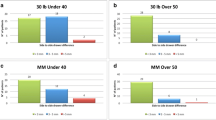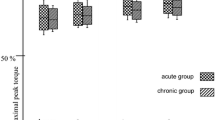Summary
A limited mobilisation cast (LMC) with hinges locked at 20 and 60 degrees has been advocated for the care after anterior cruciate ligament (ACL) surgery. The brace presumably limits motion to 20 and 60 degrees and prevents straining of the ACL.
Extension of more than 20 degrees as well as anterior drawer forces are known to strain the ACL.
We have therefore tested whether the LMC reliably limits the desired range of motion: Extension of more than 20 degrees was found in 11 of 12 patients and averaged 12 degrees.
The long leg cast reduced a 30 degree anterior drawer in unstable knees by 70%, a Lenox-Hill-Derotation Brace by 53% and the LMC by only 14%.
It was concluded that a modified Lenox-Hill Brace locked at 30 and 60 degrees of flexion provides better stress-protection of the ACL than a LMC and that the safety of the conventional long leg cast should be remembered in legs with unfavourable soft tissue configurations. If a LMC is used, it should be fixed to the trunk with a waist- or shoulder-strap and the hinges must be freely adjustable.
Zusammenfassung
Ein beweglichet Gipsverband, versehen mit Scharnieren, welche bei 20 und 60 Grad Flexion blockiert sind, ist von verschiedenen Autoren zur Behandlung nach Operationen am vorderen Kreuzband empfohlen worden. Dieser Bewegungsgips soll die Kniegelenksbeweglichkeit auf 20 bis 60° Flexion beschränken und das vordere Kreuzband vor Zugspannungen schützen.
Zu solchen Zugbelastungen kommt es im vorderen Kreuzband vor allem durch eine Knieextension von mehr als 20° and durch alle im Sinne einer vorderen Schubladenbewegung wirkenden Kräfte.
Wir haben deshalb untersucht, ob der Bewegungsgips den gewünschten Bewegungsumfang zuverlässig einschränkt: Eine Extension von mehr als 20° wurde in 11 von 12 Patienten beobachtet und betrug durchschnittlich 12°.
Der konventionelle Oberschenkel-Liegegips vermindert das vordere Schubladenphänomen bei 30° Flexion bei instabilen Kniegelenken um 70%, die Lenox-Hill-Derotationsschiene um 53% und der Bewegungsgips um 14%.
Eine modifizierte, bei 30° und 60° Flexion blockierte, Lenox-Hill-Schiene gewährleistet eine bessere Streßprotektion des vorderen Kreuzbandes als ein Bewegungsgips.
Similar content being viewed by others
References
Basset FH, Beck IL, Weiker G (1980) A modified cast brace: Its use in non-operative and post-operative management of serious knee ligament injuries. Am J Sports Med 8:63–67
Burri C, Paessler HH, Radde I (1973) Experimentelle Grundlagen zur funktionellen Behandlung nach Bandnaht und -plastik des Kniegelenkes. Z Orthop 111:368–379
Cabaud HE, Rodkey WG, Feagin IA (1979) Experimental studies of acute anterior cruciate ligament injury and repair. Am J Sports Med 7:18–22
Detenbeck LC (1974) Function of the cruciate ligaments in knee stability. Am J Sports Med 2:217–221
Gerber Ch, Matter P, Chrisman OD, Langhans M (1980) funktionelle Rehabilitation nach komplexen Knieverletzungen — Wissenschaftliche Grundlagen und Praxis. Schweiz Z Sportmed 28:37–56
Haeggmark T, Eriksson E (1979) Cylinder or mobile cast after knee ligament surgery. A clinical analysis and morphologic and enzymatic studies of changes in the quadriceps muscle. Am J Sports Med 7:48–56
Helbing G, Burri C (1977) Kniebandverletzungen — Operation und funktionelle Nachbehandlung. Zbl Chirurgie 102:787–793
Henning ChE, Lynch ML, Glick KR (1982) An in-vivo strain guage study of elongation of the anterior cruciate ligament. Am J Sports Med (submitted)
Hertel P (1980) Verletzung und Spannung von Kniebändern. Hefte Unfallheilk. Springer, Berlin Heidelberg New York
Krackow KE, Vetter WL (1981) Knee motion in a long leg cast. Am J Sports Med 9:233–239
Mason ML, Allen HS (1941) The rate of healing of tendons. Ann Surg 113:424–456
Mauck HP (1936) A new operative procedure for instability of the knee. J Bone Joint Surg 18:985–990
Munzinger U (1982) Die funktionelle Nachbehandlung von vorderen und hinteren Ersatzplastiken des Kniegelenks. Referat: 10. Internationales Symposium über spezielle Probleme der orthopädischen Chirurgie, Luzern 1982
Morrison JB (1969) Function of the knee joint in various activities. Biomed Eng 4:573–580
Noyes FR (1980) Commentary to Cabaud HE, Feagin JA, Rodkey WG: Acute anterior cruciate ligament injury and augmented repair. Am J Sports Med 8:400–401
Noyes FR (1977) Functional properties of knee ligaments and alterations induced by immobilization. Clin Orthop 123:210–242
Paessler HH, Henkemeyer H, Burri C (1972) Funktionelle Behandlung nach Bandnaht und -plastik am Kniegelenk. Langenbecks Arch Chir [Suppl Forum] 112:51–53
Paulos L, Noyes FR, Grood R (1981) Knee rehabilitation after anterior cruciate ligament reconstruction and repair. Am J Sports Med 9:140–149
Spier W, Burri C, Helbing G (1977) Weiterbehandlung nach Naht oder plastischem Ersatz von Kniebändern. Hefte Unfallheilk 129:195–199
Author information
Authors and Affiliations
Rights and permissions
About this article
Cite this article
Gerber, C., Jakob, R.P. & Ganz, R. Observations concerning the limited mobilisation cast after anterior cruciate ligament surgery. Arch. Orth. Traum. Surg. 101, 291–296 (1983). https://doi.org/10.1007/BF00379946
Received:
Issue Date:
DOI: https://doi.org/10.1007/BF00379946




